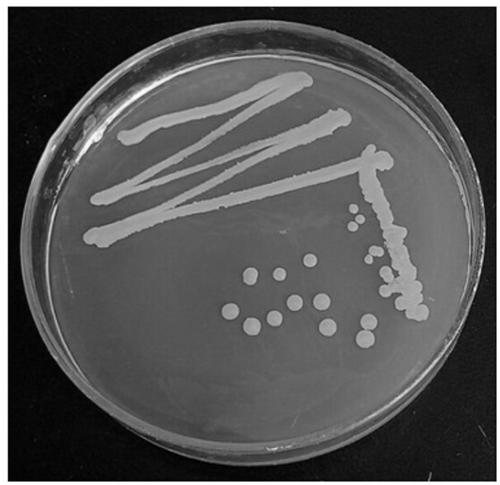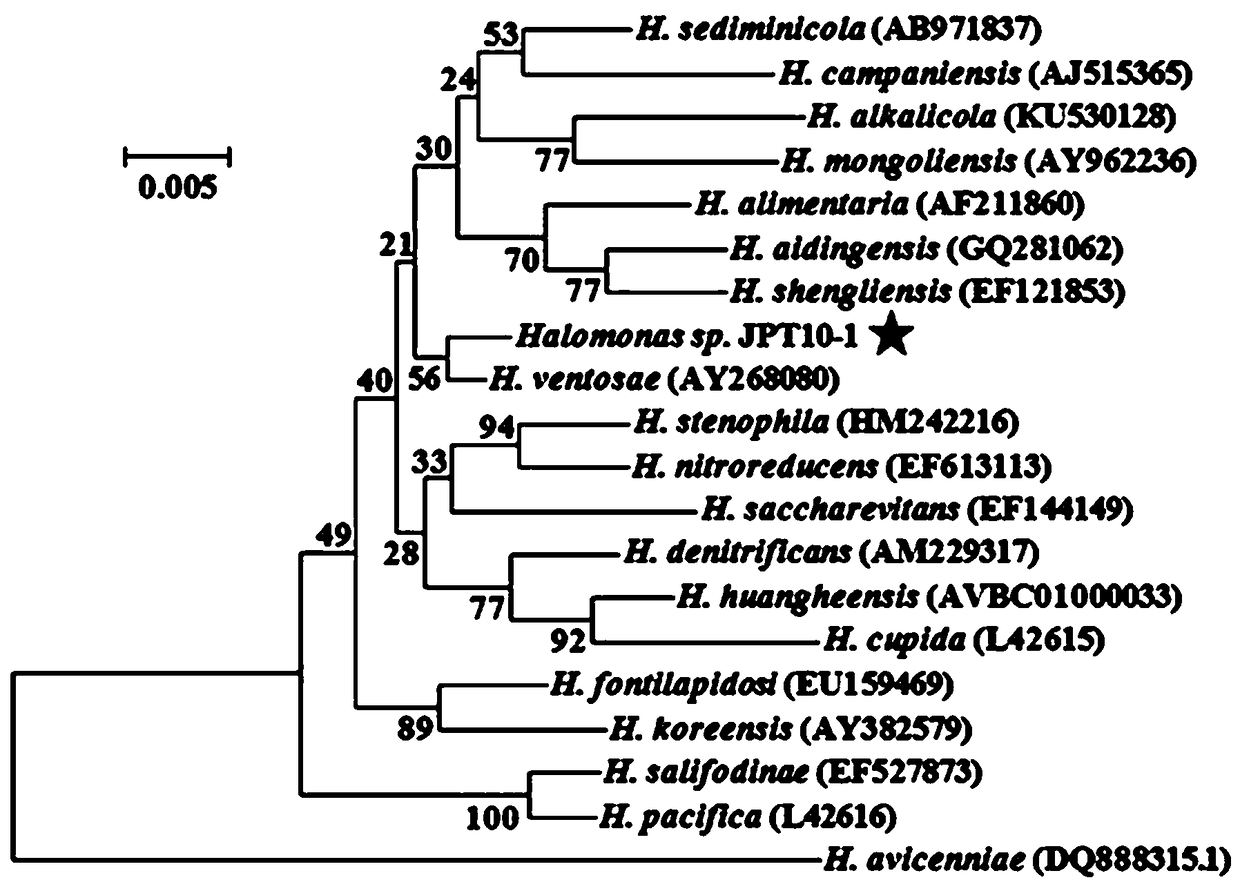Halomonas ventosae strain JPT10-1 for improving salt-tolerance capability of corns as well as bacterium agent and application of halomonas ventosae strain JPT10-1
A technology of Halomonas and Fan's salt, applied in the fields of application, bacteria, biocide, etc., can solve the problems of foreign strains not being able to colonize and grow well, weakening of physical and chemical properties, practical application limitations, etc., and achieve stable properties , high number of viable bacteria, and wide application conditions
- Summary
- Abstract
- Description
- Claims
- Application Information
AI Technical Summary
Problems solved by technology
Method used
Image
Examples
Embodiment 1
[0031] Embodiment 1: Halomonas fanneri Halomonas ventosae Isolation and purification of JPT10-1
[0032] Add 1 g of soil sample from the Suaeda salsa rhizosphere soil in the Yellow River Estuary into 10 mL of sterile water and mix to make 10 -1 Diluent, pipette 1 ml 10 -1 Add the diluent to 9 ml sterile water and mix well to make 10 -2 diluent, and so on to make 10 -3 、10 -4 、10 -5 Diluent, take 10 -3 、10 -4 、10 -5 The diluted solution was spread on high-salt LB medium (NaCl content 2000 mmol / L), placed in a constant temperature incubator at 28°C for 5 days, and single colonies with different morphological characteristics were selected for purification, and the obtained pure single colonies were prepared as The bacterial suspension was inoculated in corn seedlings, the growth of corn seedlings was observed and its biomass was measured for verification, and the strains that could significantly improve the salt tolerance of corn seedlings were selected, one of which was...
Embodiment 2
[0033] Embodiment 2: Halomonas fanneri Halomonas ventosae Identification of JPT10-1
[0034] 1. Morphological and physiological and biochemical characteristics of the strain
[0035] The colony morphology of bacterial strain JPT10-1 on the high-salt LB solid plate is as follows: figure 1 Shown is round, milky white, opaque, smooth and moist surface, neat edges, producing a small amount of pale yellow pigment. Gram staining of strains in different growth stages (logarithmic phase and stationary phase) was negative, and the morphology was oval under an optical microscope. The growth temperature of the strain JPT10-1 is 18-37°C, the pH is 5.5-8, the salt concentration is 1000-3000 mmol / L, the optimum growth temperature is 28°C, the optimum pH is 7, and the optimum salt concentration is 2000 mmol / L.
[0036] 2. 16S rDNA identification of the strain:
[0037]The genome of strain JPT10-1 was extracted with a genome extraction kit, and using it as a template, 16S rDNA univers...
Embodiment 3
[0040] Embodiment 3: the preparation of bacterial strain JPT10-1 bacterial suspension
[0041] The preparation method of the bacterial suspension of Halomonas fannerii JPT10-1 comprises the following steps: inoculate the purified bacterial strain JPT10-1 into high-salt LB liquid medium according to the inoculum size of 1% (salt concentration is 1000 mmol / L, the rest of the components are the same as LB liquid medium), after culturing in a constant temperature shaking shaker at 28 ℃ 180 rpm for 48 h, take a small amount of bacterial suspension in a 1.5 ml centrifuge tube to measure OD 600 , if it is less than 0.5, continue to cultivate to 0.5-1.0, and store it in a refrigerator at 4 °C. The JPT10-1 bacterial content in the described bacterium suspension that makes is 1 * 10 10 ~3×10 11 pieces / ml.
PUM
 Login to View More
Login to View More Abstract
Description
Claims
Application Information
 Login to View More
Login to View More - R&D
- Intellectual Property
- Life Sciences
- Materials
- Tech Scout
- Unparalleled Data Quality
- Higher Quality Content
- 60% Fewer Hallucinations
Browse by: Latest US Patents, China's latest patents, Technical Efficacy Thesaurus, Application Domain, Technology Topic, Popular Technical Reports.
© 2025 PatSnap. All rights reserved.Legal|Privacy policy|Modern Slavery Act Transparency Statement|Sitemap|About US| Contact US: help@patsnap.com



